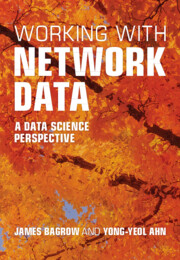Book contents
- Frontmatter
- Contents
- Preface
- Part I Background
- Part II Applications, tools, and tasks
- Interlude — Good practices for scientific computing
- Part III Fundamentals
- Chapter 21 Networks demand network thinking: the friendship paradox
- Chapter 22 Network models
- Chapter 23 Statistical models and inference
- Chapter 24 Uncertainty quantification and error analysis
- Chapter 25 Ghost in the matrix: spectral methods for networks
- Chapter 26 Embedding and machine learning
- Chapter 27 Big data and scalability
- Conclusion
- Bibliography
- Index
Chapter 23 - Statistical models and inference
from Part III - Fundamentals
Published online by Cambridge University Press: aN Invalid Date NaN
- Frontmatter
- Contents
- Preface
- Part I Background
- Part II Applications, tools, and tasks
- Interlude — Good practices for scientific computing
- Part III Fundamentals
- Chapter 21 Networks demand network thinking: the friendship paradox
- Chapter 22 Network models
- Chapter 23 Statistical models and inference
- Chapter 24 Uncertainty quantification and error analysis
- Chapter 25 Ghost in the matrix: spectral methods for networks
- Chapter 26 Embedding and machine learning
- Chapter 27 Big data and scalability
- Conclusion
- Bibliography
- Index
Summary
In this chapter, we explore several important statistical models. Statistical models allow us to perform statistical inference—the process of selecting models and making predictions about the underlying distributions—based on the data we have. Many approaches exist, from the stochastic block model and its generalizations to the edge observer model, the exponential random graph model, and the graphical LASSO. As we show in this chapter, such models help us understand our data, but using them may at times be challenging, either computationally or mathematically. For example, the model must often be specified with great care, lest it seize on a drastically unexpected network property or fall victim to degeneracy. Or the model must make implausibly strong assumptions, such as conditionally independent edges, leading us to question its applicability to our problem. Or even our data may be too large for the inference method to handle efficiently. As we discuss, the search continues for better, more tractable statistical models and more efficient, more accurate inference algorithms for network data.
Keywords
- Type
- Chapter
- Information
- Working with Network DataA Data Science Perspective, pp. 351 - 376Publisher: Cambridge University PressPrint publication year: 2024



